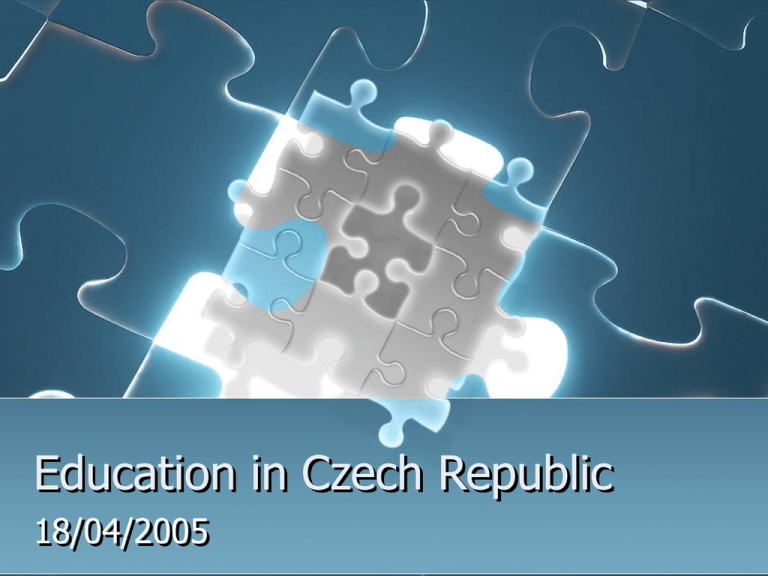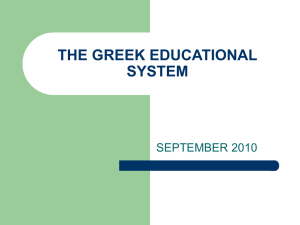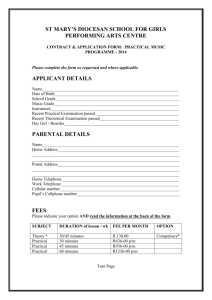Education II
advertisement

Education in Czech Republic 18/04/2005 Description of education system Education population and language of instruction In 2001 (the year of the last census), the number of people aged 29 or younger was 4 047 026 (39.6% of the population). The number of children of compulsory school age was 1 045 313 (10.2% of the population). The official language of instruction is Czech. In 2003/04 there are 21 basic schools teaching in Polish (plus 29 nursery schools and one gymnázium). Administrative control and extent of public sector funded education In 2003/04, most pupils in primary and secondary education attend public-sector schools. Since 1st January 2003 the Czech education system works on the basis of new regulations that are set by the reform of public administration. Sectoral administration was abolished; schools are administered in the frame of general administration. It is distributed between the central government, regions (which are 14) and communities. Regions are provided by high degree of autonomy. Regions are responsible for upper secondary and special schools, basic art schools and out-of-school activities (before 2001 all under responsibility of the Ministry). The governor of the region appoints a director of the educational department who becomes the main decision-maker in education. The communities are responsible for compulsory schooling. They establish and administer pre-school institutions and basic schools. The community usually fulfils this task via the Education Commission. The funding of schools is realized from two sources: capital and running costs are funded by the organizing body (i.e. region or community), salaries and teaching aids are funded by the State via regional administration. Organizing bodies appoint school heads; those appointed by the community are approved by the region, those appointed by the region are approved by the Ministry. Structure of Educational System All schools have the status of legal entities since 1st January 2003: School heads (directors) were given full responsibility for the quality of educational process, for financial management of the school, for appointing and dismissing teachers and for relations with the community and the public. By law, the school organizing body may establish a School Council (rada školy) enabling parents, pupils, staff, and the public to participate in the administration of the school. Private schools have been established since 1990 (at university level, since 1999). Schools are mostly non-confessional; the usual legal form is a for-profit or nonprofit-grant-aided organization. Private higher education institutions must be non-profit-making to be given a state grant. The funding of private schools is provided by the region. It is based on the same formula for funding of running cost, as are the public schools. Basic subsidies (50–80% of the amount of similar public institutions, according to the type) can be raised to 100% (for basic and special schools), to 90% (for upper secondary and postsecondary technical schools), or to 80% (for other type of institutions) if the school meets a set of criteria. Denominational (church) schools receive the same funding as public schools. Both private and denominational schools represent 3.46% of the total number of basic schools and 0.97% of their pupils; for upper secondary schools it is 22% of schools and 14.9% of pupils; for universities it is 53.8% of institutions and 3.2% of students in 2003/04. The Czech School Inspectorate (Česká školní inspekce) is a central control body under the direct supervision of the Ministry. It is responsible for monitoring education results, the quality of management, the efficiency of using funds and complying with binding regulations, at all levels except for higher education institutions. Pre-primary education Nursery school (mateřská škola) is a part of the education system. The basic age group is from 3 to 6. Attendance is not compulsory; nevertheless it covers near 88.7% of the age group, in the last preschool year it is almost general. Nursery schools are administered by communities. Parents can be asked to pay a maximum of 30% of the running costs. Compulsory full-time education The beginnings of the national public education go back to the school reform of 1774 under Maria Theresia. It introduced the general 6 year compulsory school education and the public state school. 1869 placed the obligatory public education on an uniform basis, which became compulsory schooling of six on eight years increased. School attendance is compulsory for nine years, usually from the ages of 6 to 15. All pupils start in a basic school (základní škola), on second stage it is possible to attend a grammar school (gymnázium). Phases Admissions criteria Catchment areas are defined, but the choice of school is free. Pupils can leave a basic (elementary) school at the end of the fifth year for the eight-year gymnázium or at the end of the seventh year for the six-year gymnázium after passing the entrance examination set by the school. There is 9.3% of the appropriate age group studying at gymnázium. Length of the school day/week/year The school year begins on 1 September and ends on 31 August of the next year. In 2003/04, the school year comprised 195 days of teaching. Lessons of 45 minutes are spread over five days a week. There is 22-25 lessons at the first stage, 27-30 lessons at the second stage (gradually). Class size/student grouping In 2003/04, the number of pupils per teacher was 14.6; the average class size was 21.3. The law defines the number of pupils per class as between minimum 17 and maximum 30. The co-educational classes are made up of pupils of the same age. At the first stage, the same teacher usually teaches all subjects whereas, at the second stage, teachers are specialized, generally in two subjects. Curricular control and content The national teaching standards set the objectives and the basic curricula content. To achieve them various educational programmes can be employed when approved. There are three national programmes. Each establishment is free to use teaching methods and textbooks (from a list approved by the Ministry). Assessment, progression and qualifications Pupils are assessed by teachers on the basis of written and oral work and homework on a scale of 5. The results of continuing assessment are summarized in a report at the end of each semester. Verbal assessment is authorized at the first stage of basic school and used by about 8% of teachers. Meetings with parents are organized to discuss their children’s progress. Pupils in difficulty can be made to repeat the year. Upper secondary and postsecondary education Types of education Upper secondary and postsecondary education General Secondary - type 1 Type of school providing this education: General School (Gymnasium) - admission after 5th year of basic school Length of program in years: 8 Age level from: 11 to 19 Certificate/diploma awarded: "maturitni vysvedceni" General Secondary - type 2 Type of school providing this education: General school (Gymnasium) - admission after 7th year of basic school Length of program in years: 6 Age level from: 13 to 19 Academic Secondary Type of school providing this education: Grammar School (Gymnasium) Length of program in years: 4 Age level from: 15 to 19 Upper secondary and postsecondary education Technical Secondary Type of school providing this education: Secondary Technical School (Technical, Health Care, Management, Arts, etc) Length of program in years: 4 Age level from: 15 to 19 Vocational Secondary - type 1 Type of school providing this education: Secondary Vocational School Length of program in years: 4 Age level from: 15 to 19 Certificate/diploma awarded: "maturitni vysvedceni" Vocational Secondary - type 2 Type of school providing this education: Secondary school Length of program in years: 2-3 Age level from: 15 to 18 Certificate/diploma awarded: Vocational Certificate Upper secondary and postsecondary education : Professional Type of school providing this education: Higher Professional Schools Length of program in years: cca 3 Age level from: 19 to 21 Certificate/diploma awarded: "Absolutorium„ Students finish with a final examination called absolutorium. The graduate is called the diplomovaný specialista – DiS. (specialist with a diploma). Admissions criteria Prerequisites for acceptance in upper secondary education are completing a compulsory education and successfully meeting entrance requirements. Pupils can apply for one or more schools of their choice (!!!). Curricular control and content The Ministry lays down educational standards determining the aims and content and approves the curricula with a big flexibility. At gymnázium, there are prescribed 29–21 lessons of the total 31 lessons. The school head determines the rest according to the school profile. At technical schools, the total number of lessons is 33, while the proportion of general subjects and vocational ones is about 40:60. Some lessons are optional. At the vocational schools, there are 33 lessons too; the proportion of general subjects, vocational subjects and practical training is varying. Practical training in the three year courses (a prevailing type) can take 30–45 % of lessons. Assessment, progression and qualifications All upper secondary schools organise their own final examination: maturita, … at technical and vocational schools, a part of the examination is practical. The leavers of vocational school are awarded a výuční list (certificate). Tertiary education Higher education: Main laws/decrees governing higher education: Decree: Higher Education Institutions Act no. 111/1998 Concerns: all higher education institutions Academic year: Classes from: Sep to Aug Long vacation from: 15 Jun to 1 Sep Higher education institutions are either university-type (in 2004 28 institutions – 24 public, 4 state) or non-university type (28 private institutions). The study programmes are prepared by individual institutions/faculties and approved by the Accreditation Commission of CR. University level studies: University level first stage: Bachelor studies (Bc. = "Bakalar"): The Bachelor study programmes usually take 3 to 4 years, covering all main disciplines, except in Medicine, Veterinary Medicine, Pharmacy, Architecture and Law. It is conceived either as an independent course whose graduates are fully qualified for particular professions, or as the first stage of longer studies whose graduates can continue towards the Magistr degree. This cycle leads to the academic degree of "Bakalar" Students must sit for a final state examination, part of which is also the defence of the Bachelor thesis. University level studies: University level second stage: Master studies (Mgr. = "Magistr"): The Master study programmes last mostly for five years and lead to the title of Magistr (Mgr) or "Inzenyr" (Ing.). The new Act enables holders of the title of Magistr to sit for a State Rigorosum examination in the same field and defend a dissertation to acquire the academic degree of Doktor followed by the name of the field "Doktor prav" (JUDr), "Doktor filosofie" (PhDr), "Doktor prirodnich ved" (RNDr), "Doktor farmacie" (Phar.Dr.) and "Doktor teologie" (ThDr). University level studies: University level third stage: Doctoral studies: (Ph.D.) The third and highest level of higher education consits in studies for the Doctorate which take place under the guidance of a tutor. The programme is aimed at scientific research and independent study. Holders of the Master's Degree may apply. Studies last for three years and end with the State Doctorate examination and the defence of a dissertation. Access The maturita certificate is the minimum entrance qualification for all tertiary education. Each institution defines its own admission criteria and determines the content of the entrance examination. Education - Special Needs Special schools exist from pre-school through to upper secondary level. Their curriculum and qualifications are as close as possible to those of mainstream schools; 3.6% of the population falls outside mainstream education. Attendance at a special school requires a recommendation from an appropriate authority and parental consent. The new policy for integration is relatively recent but progressing. Teachers Four-year teacher training for pre-compulsory education is organized in general at the upper secondary level; there are also university courses at a Bachelor or Master level (three or four years). Would-be teachers at other levels of education must obtain a university qualification, generally Master level (for which study lasts four or five years). Teachers do not have civil servant status. Teacher education: Training of pre-primary and primary/basic school teachers Teachers of basic schools are trained at Faculties of Education. Teachers of the first stage of primary school follow a four-year course, those for the second stage follow a five-year course combining two subjects. Those specialized in Music Education are usually graduates of four-year or six-year conservatories. Training of secondary school teachers Teachers for secondary general schools and secondary technical schools are trained at Faculties of Education, Arts, Philosophy, Natural Sciences, Mathematics and Physics, Physical Education and Sports as well as at technical, economic and agricultural Faculties. They obtain their qualifications through Master's degree courses. Training of higher education teachers Teachers at higher education institutions must hold an academic degree awarded on the base of successfully completing of Magistr study programme, and usually hold the degree of Ph.D. Academic staff members may be appointed to the following ranks: "profesor" (professor), "docent" (associate professor), "odborny asistent" (senior assistant), "asistent" (assistant) and "lektor" (lecturer). Docent (associate professor) in a specific field is appointed by the Rector on the base of habilitation procedure. A professor in a specific field is appointed by the President of the Czech Republic on the base of procedure for the appointment of a professor. Ongoing Reforms and Topics of Debate in Education Ongoing reforms and discussions on the development of education system in the Czech Republic are based on the main document the National Programme of the Development of Education in the Czech Republic White Paper, other national concepts and strategies and documents issued at the European and international level. After the Parliamentary election in June 2002 and the new Government establishment the work on the new acts for education has started again; the three acts were approved 24 September 2004. They come into effect 1st January 2005 with the exception of some articles. The Education Act will replace (repaced!!!) all current laws on pre-primary, basic, upper secondary, tertiary technical and extracurricular education and on the administrations of education system. The Act on Educational Staff and their Career Development is intended to encourage educational staff to and create the base for further education. The implementation of the proposed procedures will have an impact on the salaries of teachers in relation to their qualifications and specific tasks. The third approved act resumes changes in related 15 acts. Consequently, implementary regulations are prepared. In the sphere of higher education the main issues discussed are related with the Bologna and Lisbon processes and with the economic situation of HE: Restructuralisation of the study programmes and support for doctoral studies; Pathway through the system of education: permeability between higher professional schools (vyšší odborné školy) and higher education institutions, !!! recognition of the previous education, gained outside HE (Lifelong learning provisions) for further study; Closer links between educational and R&D activities of HE institutions; Quality assurance; Changing the system of HE financing: to strengthen the qualitative criteria in the formula funding, to support (beside formula funding) the allocations to strategic and R&D programmes, to support funding from private sources, to transfer financial support for student’s meals and accommodation from institutions to students. The curricular reform at ISCED 1, 2 and 3 is in progress: framework educational programmes (FEP) that represent a central level of the curricular system and define educational goals and key competencies as well as educational contents necessary for their achievement, have been in different phases of development (end). On the basis of the FEP schools will prepare their own school educational programmes. The reform of public administration has brought substantial changes in education between 1st January 2001 and 31 December 2002. In 2003 the public discussion continued focussing on the division of competencies and responsibilities between the regions and central institutions and on the funding. Regions require for more autonomy, which is conditioned financially. That is why regions ask for larger share in taxes and their responsibility for funding of schools instead of the Ministry. Non-traditional studies: Distance higher education Four distance education centres in Prague, Liberec, Brno and Olomouc have been established. Some non-governmental educational institutions, such as J.A. Comenius and the Open University Fund also offer distance education. The National Centre for Distance Education was established in 1995 as a department of the Centre for Higher Education Studies. Lifelong higher education Several institutions, centres or institutes of lifelong learning have been established which offer a whole range of educational activities to upgrade qualfiications, for requalification and special interest activities. In the sphere of adult education, a number of higher education institutions cooperate with foreign universities in various fields, and more especially in Management and Languages. There are also Universities of the Third Age which have been created in sixteen faculties.






